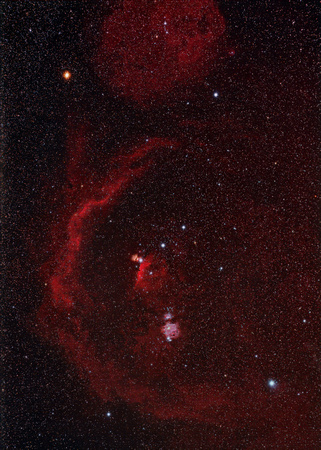Date: 2/17/2010
Target: Orion Widefield in HaRGB
Lens: Canon EF 50mm f/1.8 II (
setup here)
Camera: Canon 40D (modified)
Filter: Astronomik 12nm Ha EOS Clip
Exposures:
RGB: 30x120s (1.0h) @ ISO1600
Ha: 15x600s (2.5h) @ ISO1600
Framing: North is up
Start Temp: 23F
End Temp: 20F
Location: Mocksville, NC
Seeing: 2/5
Transparency: 3/5
Start Time: 8:00PM
End Time: 1:00AM
Captured using Nebulosity, stacked using DeepSkyStacker, processed in Photoshop.
Anacortes Telescope and Wild Bird Picture of the Day February 22, 2010Winner - Digital_Astro Monthly Challenge March 2010This image nicely frames one of the most famous, and most recognizable, constellations in the sky --
Orion, The Hunter.
Across the center, you will see three bright stars that make up the "belt" of Orion. Hanging down from this are three "stars" that form his sword, though the brightest of these stars is actually the Orion nebula. Near the top, you can see two bright stars where Orion's shoulders would be. The large orange star near the top left is
Betelgeuse. It is 640 light-years away, but is huge. If it were our sun, it would extend out beyond Mars! Near the bottom are two bright stars corredsponding to Orion's feet.
This is a very active region of space. The beautiful red emission nebulae surrounds the region. The half-circle of red nebulae to the left is
Bernard's Loop. If you look closely, you can see two very popular imaging targets near the lower center, below Orion's "Belt": The
Horsehead Nebula, and the
Great Orion Nebula. I've imaged both of these with telescopes, so you can see what they look like close-up:
The Horsehead Nebula The Great Orion Nebula


